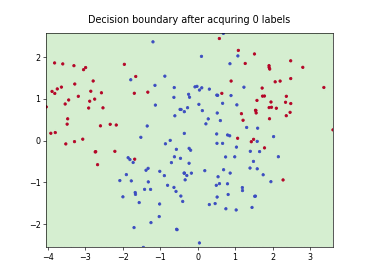skactiveml.pool.ValueOfInformationEER#
- class skactiveml.pool.ValueOfInformationEER(cost_matrix=None, consider_unlabeled=True, consider_labeled=True, candidate_to_labeled=True, subtract_current=False, normalize=False, missing_label=nan, random_state=None)[source]#
Bases:
ExpectedErrorReductionThis class implements the expected error method from [1] that estimates the value of information. This method can be extended in a way that it also implements [2] and [3]. The default parameters describe [1].
- Therefore, it implements the following two steps:
determining ever candidates x label pair and simulate its outcome in the classifier by simulating it
determining some kind of risk for the new classifier
- Parameters
- cost_matrix: array-like, shape (n_classes, n_classes), optional
- (default=None)
Cost matrix with cost_matrix[i,j] defining the cost of predicting class j for a sample with the actual class i. Used for misclassification loss and ignored for log loss.
- consider_unlabeledbool, optional (default=True)
If True, the error is estimated on the unlabeled samples.
- consider_labeledbool, optional (default=True)
If True, the error is estimated on the labeled samples.
- candidate_to_labeledbool, optional (default=True)
If True, the candidate with the simulated label is added to the labeled set. As this label is considered to be correct, it will be evaluated under the consider_labeled flag then.
- subtract_currentbool, optional (default=False)
If True, the current error estimate is subtracted from the simulated score. This might be helpful to define a stopping criterion as in [2].
- normalizebool, optional (default=False)
If True the error terms are normalized by the number of evaluation samples such that the errors represent the average error instead of the summed error. This will be done independently for the simulated and the current error.
- missing_labelscalar or string or np.nan or None, default=np.nan
Value to represent a missing label.
- random_stateint or np.random.RandomState
The random state to use.
References
- [1] Kapoor, Ashish, Eric Horvitz, and Sumit Basu. “Selective Supervision:
Guiding Supervised Learning with Decision-Theoretic Active Learning.” IJCAI. Vol. 7. 2007.
- [2] Joshi, A. J., Porikli, F., & Papanikolopoulos, N. P. (2012).
Scalable active learning for multiclass image classification. IEEE TrPAMI, 34(11), pp. 2259-2273.
- [3] Margineantu, D. D. (2005). Active cost-sensitive learning.
In IJCAI (Vol. 5, pp. 1622-1623).
Methods
Get metadata routing of this object.
get_params([deep])Get parameters for this estimator.
query(X, y, clf[, sample_weight, fit_clf, ...])Determines for which candidate samples labels are to be queried.
set_params(**params)Set the parameters of this estimator.
- get_metadata_routing()#
Get metadata routing of this object.
Please check User Guide on how the routing mechanism works.
- Returns
- routingMetadataRequest
A
MetadataRequestencapsulating routing information.
- get_params(deep=True)#
Get parameters for this estimator.
- Parameters
- deepbool, default=True
If True, will return the parameters for this estimator and contained subobjects that are estimators.
- Returns
- paramsdict
Parameter names mapped to their values.
- query(X, y, clf, sample_weight=None, fit_clf=True, ignore_partial_fit=True, candidates=None, batch_size=1, return_utilities=False)[source]#
Determines for which candidate samples labels are to be queried.
- Parameters
- Xarray-like of shape (n_samples, n_features)
Training data set, usually complete, i.e. including the labeled and unlabeled samples.
- yarray-like of shape (n_samples)
Labels of the training data set (possibly including unlabeled ones indicated by self.MISSING_LABEL.
- clfskactiveml.base.SkactivemlClassifier
Model implementing the methods fit and predict_proba.
- fit_clfbool, optional (default=True)
Defines whether the classifier should be fitted on X, y, and sample_weight.
- ignore_partial_fitbool, optional (default=True)
Relevant in cases where clf implements partial_fit. If True, the partial_fit function is ignored and fit is used instead.
- sample_weightarray-like of shape (n_samples), optional
- (default=None)
Weights of training samples in X.
- candidatesNone or array-like of shape (n_candidates), dtype=int or
array-like of shape (n_candidates, n_features), optional (default=None) If candidates is None, the unlabeled samples from (X,y) are considered as candidates. If candidates is of shape (n_candidates) and of type int, candidates is considered as the indices of the samples in (X,y). If candidates is of shape (n_candidates, n_features), the candidates are directly given in candidates (not necessarily contained in X). This is not supported by all query strategies.
- batch_sizeint, optional (default=1)
The number of samples to be selected in one AL cycle.
- return_utilitiesbool, optional (default=False)
If true, also return the utilities based on the query strategy.
- Returns
- query_indicesnumpy.ndarray of shape (batch_size)
The query_indices indicate for which candidate sample a label is to queried, e.g., query_indices[0] indicates the first selected sample. If candidates is None or of shape (n_candidates), the indexing refers to samples in X. If candidates is of shape (n_candidates, n_features), the indexing refers to samples in candidates.
- utilitiesnumpy.ndarray of shape (batch_size, n_samples) or
numpy.ndarray of shape (batch_size, n_candidates) The utilities of samples after each selected sample of the batch, e.g., utilities[0] indicates the utilities used for selecting the first sample (with index query_indices[0]) of the batch. Utilities for labeled samples will be set to np.nan. If candidates is None or of shape (n_candidates), the indexing refers to samples in X. If candidates is of shape (n_candidates, n_features), the indexing refers to samples in candidates.
- set_params(**params)#
Set the parameters of this estimator.
The method works on simple estimators as well as on nested objects (such as
Pipeline). The latter have parameters of the form<component>__<parameter>so that it’s possible to update each component of a nested object.- Parameters
- **paramsdict
Estimator parameters.
- Returns
- selfestimator instance
Estimator instance.


